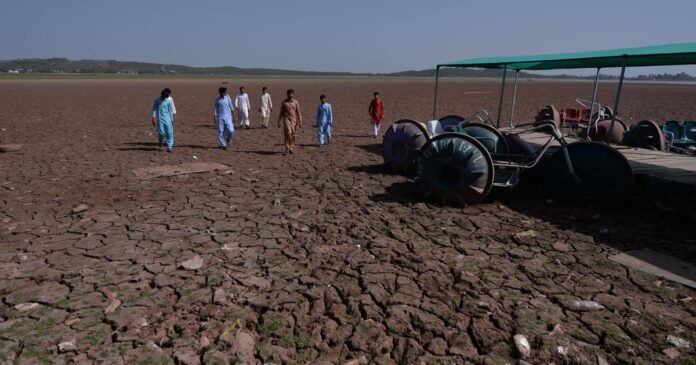As Pakistan grapples with the daunting challenges posed by climate change, the nation stands at a critical juncture, where the urgency to address environmental threats is matched only by the potential for transformative sustainable development. Pakistan’s vulnerabilities, accentuated by geographical factors and dependence on climate-sensitive sectors, place it at the frontline of a battle against rising temperatures, shifting precipitation patterns, and glacial melt.
The impact of climate change on water resources is stark. Changes in precipitation patterns and the melting of glaciers in Pakistan’s mountainous regions contribute to water scarcity, posing a direct threat to agriculture, a sector that contributes significantly to the country’s economy. With an increased demand for water and reduced availability, the spectre of a food security crisis looms large. According to the Pakistan Bureau of Statistics, Pakistan’s agriculture sector accounts for over 24 percent of the GDP and employs nearly 50 percent of the country’s workforce. However, the changing climate, coupled with water scarcity, poses a significant threat to both food security and livelihoods.
The frequency and intensity of extreme weather events, including floods, droughts, and heat waves, are on the rise. Over the past decade, the country has witnessed a surge in these calamities, leading to the loss of lives, displacement of communities, and extensive damage to infrastructure. The economic toll is substantial, with estimates suggesting that the economic cost of climate-related disasters in Pakistan has averaged around $3.8 billion annually. Coastal areas, particularly vulnerable to storm surges and sea-level rise, face additional risks, exacerbating the challenges faced by communities along the coast.
Pakistan’s mountainous regions, home to crucial glaciers, are experiencing a concerning retreat. The melting of glaciers, a consequence of global warming, not only contributes to variability in river flows but also poses risks of glacial lake outburst floods (GLOFs), impacting downstream communities. Data indicates that the glaciers in the Hindu Kush Himalayan region, which includes parts of Pakistan, are retreating at an alarming rate each year. This retreat not only threatens freshwater resources but also endangers the delicate balance of ecosystems dependent on glacial melt.
As temperature and precipitation patterns shift, so does the distribution of disease vectors. Pakistan is witnessing a rise in vector-borne diseases, such as malaria and dengue, as changing climatic conditions create favourable environments for their spread. This places an additional burden on healthcare systems already grappling with various challenges. According to health statistics, the incidence of vector-borne diseases has seen a steady increase in recent years, requiring a concerted effort to address both the health and environmental aspects of these emerging threats.
As Pakistan faces the dual challenges and opportunities presented by climate change, a proactive, integrated approach is imperative. Government policies, private sector engagement, and community participation must align to unlock the potential benefits of sustainable development. No doubt, the nation stands at the precipice of a climate-resilient future, where strategic initiatives can transform adversity.
Rapid urbanization, coupled with rising temperatures, contributes to the development of urban heat islands. Major cities, including Karachi and Lahore, experience higher temperatures compared to surrounding rural areas. This not only poses health risks but also leads to increased energy consumption for cooling. Recent studies indicate that urban heat islands can result in temperature differentials of up to 8-12 degrees C, amplifying the challenges faced by urban populations.
Amidst these challenges, there exist opportunities for innovation, sustainable development, and economic growth. Pakistan’s abundant solar and wind resources provide a foundation for the development of renewable energy projects. The country’s transition to a low-carbon energy system is gaining momentum, with investments in solar and wind energy infrastructure contributing not only to climate change mitigation but also enhancing energy security.
The agricultural sector, recognizing the need for adaptation, is adopting climate-smart practices. Drought-resistant crops, precision agriculture technologies, and sustainable water management practices are becoming integral components of the sector’s resilience strategy. Measures related to climate-smart agriculture not only enhance the sector’s ability to withstand climate impacts but also promote sustainable food production.
Given the critical issue of water scarcity, there is a growing need for innovative water management solutions. Technologies that improve water-use efficiency, reduce wastage, and enhance storage and distribution systems play a crucial role in addressing the water challenges faced by the country. Improving water-use efficiency in agriculture alone could save up to 30% of the country’s water resources.
Projects focused on ecosystem restoration and conservation, including afforestation and reforestation initiatives, sustainable land management, and biodiversity conservation efforts, contribute to both climate resilience and environmental sustainability. The increasing global focus on sustainable and green finance presents opportunities for Pakistan to attract investments in environmentally friendly projects. Green bonds, sustainable infrastructure development, and investments in clean energy are avenues through which the nation can chart a sustainable future.
The need for climate-resilient infrastructure is undeniable. Investments in infrastructure that can withstand extreme weather events, such as floods and cyclones, provide opportunities for the construction and engineering sectors. Resilient urban planning and the development of climate-resilient buildings and transportation systems are integral components of building a climate-resilient future.
Accurate and timely climate information is crucial for decision-making in various sectors. Opportunities exist for the development of climate information services, including climate modelling, early warning systems, and technologies that help businesses and communities adapt to changing climate conditions. The pursuit of climate goals opens up opportunities for technology innovation, fostering the development of clean technologies, energy-efficient solutions, and sustainable practices across various sectors.
As Pakistan faces the dual challenges and opportunities presented by climate change, a proactive, integrated approach is imperative. Government policies, private sector engagement, and community participation must align to unlock the potential benefits of sustainable development. No doubt, the nation stands at the precipice of a climate-resilient future, where strategic initiatives can transform adversity.























